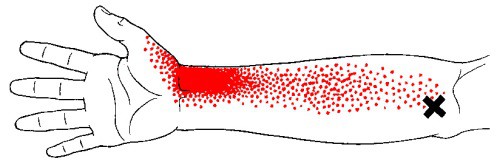Pronator Teres: Functional Anatomy Guide
The pronator teres (L. pronus, lying face down ; teres, round and long.) is an elongated, cylindrical forearm muscle that crosses the gap between radius and ulna.
It’s the strongest of the two pronator muscles. However, it is only active during rapid or resisted forearm pronation, which it carries out with help from the pronator quadratus. Notably, it also plays a minor role in elbow flexion.
It is part of the superficial anterior compartment of the forearm.
The pronator teres, which has a humeral head and an ulnar head, is found lateral to the palmaris longus and medial to the flexor carpi radialis.
Its ulnar head is deep to the flexor carpi radialis, and the distal end of the muscle is deep to the brachioradialis.
From their origins on the distal humerus and and proximal ulna, the parallel-oriented fibers of the pronator teres travel inferolaterally and converge before inserting on the lateral radius. The muscle has a fusiform shape.
Also Called
- Pronator
- Front of the forearm
Origin, Insertion, Action & Nerve Supply
Exercises:
Note: The table below contains exercises that work the pronator teres directly. These are the same exercises that target the pronator quadratus. Both pronator muscles are trained indirectly through isometric contraction on pronated grip exercises (e.g. reverse curls, overhand rows, bench press, pull up).

Tutorial: N/A

Tutorial: N/A

Tutorial: N/A

Tutorial: N/A

Tutorial: N/A
- Flexbar forearm pronation
- Band seated forearm pronation
- Band standing forearm pronation

Tutorial: N/A

Tutorial: N/A

Tutorial: N/A
Stretches & Myofascial Release Techniques:
Stretches
The following stretches target both the pronator teres and pronator quadratus.

Tutorial: N/A

Tutorial: N/A
Self Myofascial Release Techniques
When using these techniques, give special attention to the trigger point shown in the image below.


Tutorial: N/A

Tutorial: N/A

Tutorial: N/A

Tutorial: N/A
Common Issues:
- Overactive/Short Pronator Teres: The pronator teres has a tendency to become overactive and short due to overuse. Overuse is caused by repetitive activities involving a pronated forearm position or active forearm pronation movement, including throwing, some tennis strokes, swinging a bat or golf club, and turning a screwdriver or wrench. Also, exercises that involve holding the forearm in a pronated position and isometrically contracting the pronator teres can also contribute to overuse (e.g. reverse curls, reverse wrist curls, bench press, overhand rows, pull up). As the pronator teres becomes tighter and shorter, tension throughout the muscle increases and tissue quality deteriorates, which often leads to one of the two injuries discussed in the bullet points, below.
- Pronator Teres Syndrome: Pronator teres syndrome refers to the compression of the median nerve as it passes between the two heads of the pronator teres. The nerve compression may be due to hypertrophy of the pronator teres or a buildup of scar tissue/adhesions caused by overuse and muscle tightness. The result is pain, numbness and tingling in the front of the forearm, the palm and all fingers except the pinky. These symptoms are similar to carpal tunnel syndrome, which involves median nerve compression at the wrist. The difference is that carpal tunnel syndrome doesn’t affect the forearm or palm.
- Medial Epicondylitis: Medial epicondylitis, or golfer’s elbow as it’s more commonly called, is a degenerative tendon condition that affects the common flexor tendon, producing pain on the inside of the elbow. It’s caused by overuse and tightness of the wrist flexors and pronator teres.
Training Notes:
- If your pronator teres is overactive and short, do the following:
- Reduce time spent doing repetitive activities involving a pronated position and pronation-supination movements, especially if wrist flexion and intense gripping is also involved. As mentioned earlier, this includes throwing, rowing, swinging a racquet/bat/club/etc., as well as using tools like screwdrivers and wrenches, to name a few things. And if you’re an avid arm-wrestler, then you’ll certainly need to cut back on that, as well. 😀
- If you happen to be doing direct pronation exercises (e.g. dumbbell pronation) or supination exercises (e.g. dumbbell supination) in your routine, stop doing so.
- Use a supinated grip or neutral grip instead of a pronated grip when it is practical to do so (e.g. do dumbbell rows or underhand rows instead of overhand rows; chin ups or neutral grip pull ups instead of pull ups; neutral grip dumbbell bench press or Swiss bar bench press instead of barbell bench press). You don’t have to change your grip on every single exercise where changing your grip is possible; do it for a couple different movements start with, then if you feel it would be beneficial, do it for a couple more.
- Perform pronator teres stretches and release techniques every day, as part of a daily mobility routine. Also include release techniques for the pronator quadratus since it, too, is most likely overactive. It may also be helpful to include these techniques in your warm up routine before workouts that involve overhand grip exercises (e.g. rows, deadlift, bench press, pull ups, reverse curls, etc.) or direct forearm training.
- If the pronator teres are overactive/short, then the wrist flexors probably are, too. If this is the case for you, see how to treat overactive/short wrist flexors.
- If you think you have pronator teres syndrome, see how to treat pronator teres syndrome (article coming soon).
- If you have medial epicondylitis, see how to treat golfer’s elbow (article coming soon).
- If your pronator teres is healthy, then there is generally no need to train it directly. However, if you want to do so for maintenance purposes, then I recommend 2-3 sets of 8-15 reps, 1-2 times per week, when you train forearms. Do the same for the supinator.
Related Muscles
- Pronator quadratus
- Wrist flexors
















